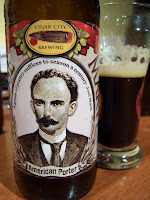 Oxfordshire, England. As the bottle informs us, Hook Norton is “where progress is measured in pints.” Now that’s my kind of measure.
Oxfordshire, England. As the bottle informs us, Hook Norton is “where progress is measured in pints.” Now that’s my kind of measure.Hooky Bitter pours a clear bright orange-ish copper with a minimal eggshell white head. The nose is a combination of fruit esters, grainy caramel biscuit malt, and some slight butterscotch and butter. In other words, it is very, very British. There could be a touch of bitterness behind that, but the fruit, caramel, and butterscotch effectively mask and cover it. That is, if it is there. Flavors start with a caramel graininess and biscuit malt mixed with generic fruit flavors, which I am guessing are from the
 yeast. The butterscotch comes in at the end of the front and carries into the middle, along with drying from the bitterness and a touch of cracker. As that fades, there are low levels of caramel mixed with a creamy turn that heads us towards the finish, which is dry, mineral-ly, an
yeast. The butterscotch comes in at the end of the front and carries into the middle, along with drying from the bitterness and a touch of cracker. As that fades, there are low levels of caramel mixed with a creamy turn that heads us towards the finish, which is dry, mineral-ly, an d ever so slightly papery with some lingering butter and hop bitterness. Like I said, very British. The body is medium to light with a smooth creamy mouthfeel; the beer is pleasant and easy drinking—there is surprising body and complexity for the size of the beer. You could, quite easily, hit this all night long and have a rather pleasant and enjoyable session. Nice job, guys.
d ever so slightly papery with some lingering butter and hop bitterness. Like I said, very British. The body is medium to light with a smooth creamy mouthfeel; the beer is pleasant and easy drinking—there is surprising body and complexity for the size of the beer. You could, quite easily, hit this all night long and have a rather pleasant and enjoyable session. Nice job, guys.From the bottle: “Hooky Bitter is a subtly balanced golden bitter, hoppy to the nose, malty on the palate—the classic session beer, eminently drinkable. Cheers!”
ABV: 3.6%
(4/30/2011)






























